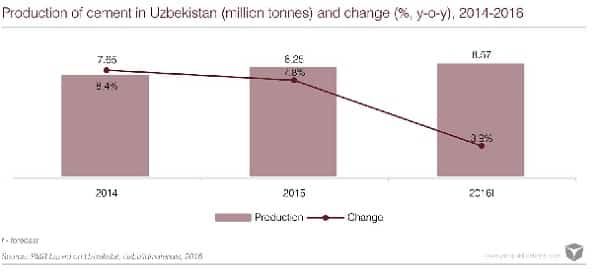The construction industry has been among the major drivers of the country’s economic growth over the past ten years. Between 2006 and 2015, the country’s construction output surged in real terms by 16.3% on average every year, and by 17.8% in the last three years. Strong growth in the construction industry in Uzbekistan has provided decisive support for domestic production of building materials, particularly in terms of cement.
Uzbekistan is the most heavily populated CIS country in Central Asia, with about 31 million people. However, in terms of per capita housing space it lags behind Kazakhstan, with 15.2 m² in Uzbekistan, as opposed to 21 m² in Kazakhstan, despite the fact that officially economic activity has been booming in Uzbekistan for many years. The economy of Uzbekistan surged by 8% in 2015 and is likely to expand further by almost 7% this year. Moreover, according to official data, annual GDP growth rates exceeded 7% every year between 2005 and 2015, with rates fluctuating between 8.0% and 8.3% over the last five years.
With an average GDP growth rate of 8.1% between 2011 and 2015, Uzbekistan’s economy performed much better than its Kazakh, Russian, Belarusian and Ukrainian counterparts, which recorded, on average, changes of 4.6%, 1.2%, 1.2% and -2.2%, respectively. In September 2015, the IMF praised “Uzbekistan’s strong growth in recent years and the authorities’ prudent macroeconomic management, which has yielded healthy fiscal balances, large external buffers, and a low amount of public debt.”
According to Uzbuildmaterials, cement production came to 8.3 million tonnes in 2015, the most substantial output ever achieved in Uzbekistan, a steady increase from 3.28 million tonnes in 2000. In 2016 the upward trend in the cement industry in Uzbekistan is likely to continue, although production is likely to expand by no more than 4%, to 8.6 million tonnes.


Uzbekistan’s cement market has seen substantial development since 2010. Between 2010 and H1 2016 six new cement production facilities were built around the country, expanding its production capacity by more than 3 million tonnes. The United Cement Group put a cement grinding station with a production capacity of about 1 million tonnes into operation in Yangiyul in 2010, whereas the Almalyk Mining-Metallurgical Complex activated the first phase of a new cement plant in the Dzhizaksk Province in March 2014. Almalyk MMC’s plant absorbed total investment of about $120m in the first phase, and included a Portland cement production unit with a capacity of 760,000 tonnes per annum, which also is able to produce 360,000 tonnes of white cement. The second phase required another $36m and was completed in 2016. It included expansion of the plant’s Portland cement production capacity to 1 million tonnes. It should be noted that both plants were built with the help of international contractors: China CAMC Engineering acted as the general contractor at the Yangiyul Grinding Station, whereas DAL Teknik Makina managed the construction of the cement plant in the Dzhizaksk Province.
There were two more plants put into operation in 2014, in the Fergana and Andizhansk Provinces, but these have produced a considerably less significant boost to the market,as between them they can produce only up to 250,000 tonnes of cement per annum. Another two plants were completed in 2016, in Fargona Province (capacity – 350,000 tonnes/year, investor – Turon Eco Cement) and Karakalpakstan (capacity 200,000 tonnes/year, investor – Titan-cement).
The Uzbek authorities expect the country’s cement production capacity to be expanded to 16-17 million tonnes by 2020, from about 9 million tonnes in 2015. About $40m is to be invested in the modernisation of Qizilqumsement’s three production units, in order to increase the plant’s capacity by 8-10%. Another $150m is to be allocated for the construction of the fourth production line (capacity – 1.6 million tonnes), which should be activated in 2018. In addition, the Almalyk MiningMetallurgical Complex most probably will invest $225m in the construction of a new plant with a 1.5 million tonne production capacity in the Surkhandarinsk Province, which is due to be activated by 2019.

There has been a steady increase in the government’s influence on the building materials industry in recent years. Uzbekistan’s authorities are determined to continue to provide financial, infrastructure and legal incentives to investors willing to set up new plants to produce materials previously not manufactured in the country. In recent years new production units capable of supplying over 30 new building materials not previously manufactured in Uzbekistan have been activated across the country, including dry-building mixtures, plasterboard, bitumen membrane and ceramic sanitary ware. Between 2015 and 2019 there are plans to build new production facilities capable of supplying over 20 building products not previously manufactured in Uzbekistan. For example, two extensive investment projects will be implemented by Knauf. The company opened a 20 million m² capacity plasterboard plant in the Bukhara Province in 2011, with capacity being expanded to 25 million m² by 2015. According to an investment memorandum signed by Knauf with the government in early 2015, the company plans to invest $53m in the construction of a dry-building mixture plant (60,000 tonnes/year) and the expansion of plasterboard production capacity by 8 million m²/year in the near future. Currently, there are more than 50 manufacturers of dry-building mixtures in Uzbekistan
Tags pmr
 Constructionshows
Constructionshows